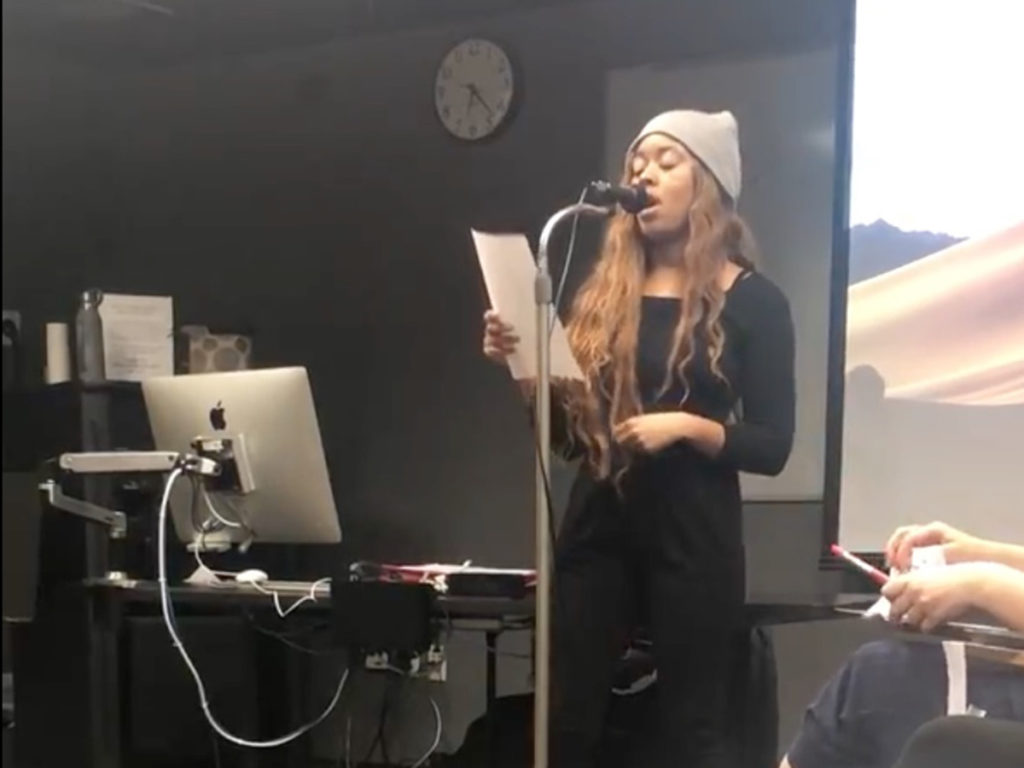Poetry and Song Class Blends Collaboration, Creativity, Courage

By Erin Clossey
The next-to-the-last day of classes this semester was supposed to be a live concert for students in Scott Wheeler’s and Anna Ross’ Poetry and Song class.
Over the course of the semester, the students – many of whom had never before written a bar of music – turned existing and original poems into songs, and the class was set to culminate in a live performance of their work at a local coffeehouse or similar venue.
The COVID-19 pandemic put an end to those plans, forcing the class online and canceling the coffeehouse event. But the show went on, in the form of a playlist from the set they would’ve done live.
LISTEN: POETRY AND SONG PLAYLIST
Poetry and Song, developed by Wheeler, senior distinguished artist-in-residence in the Performing Arts department, and co-taught by Ross, a Writing, Literature and Publishing affiliated faculty member, doesn’t slowly ease students into the process of writing – regardless of whether or not they’ve ever written a poem or a song before.
The first day of class the group discusses a handful of poems selected by Ross. At the end of the class, they’re asked to choose one and set it to music. In week two, they sing or rap their song for the rest of the class, either accompanying themselves with an instrument they brought or playing the music they recorded on Garage Band or a similar app.
“It sets up how we teach what songwriting is,” Wheeler said. “And they find themselves [saying] ‘Oh, somebody took a totally different approach, I should try that soon.’”
Ross said the first time she taught the class with Wheeler, she couldn’t believe how fast it moves, throwing students into the songwriting process in the first week.
“That’s a big hurdle for some people to get over, but once they do it’s such a wonderful communal experience,” she said. “They really support each other, and they have great ideas for each other.”
For week three, they’re writing their collaborating with a classmate to turn their own poems into songs.
Ross, a poet who had studied opera herself, said the class talks about common elements of poetry and music – they both use meter, and they each create imagery. She said she’s always struck by how differently students approach a word once music enters the picture.
“The word ‘lonely’ evokes a particular tone. You could set it as very long melancholy musical line, but oftentimes students will often turn it around and turn it into a hopeful note,” Ross said.
There is always a wide range of musical (and poetry) experience in the class – from complete novices to students who have played in a band for years and write their own songs. To sort of “even the playing field,” students are required to collaborate with different people throughout the semester, and to give each other assignments, asking each other to try different things with their songs and lyrics, Ross said.
Students also are asked to think about the ways poems and songs are different. When setting existing poems to music, they are encouraged to move phrases around and create repetition where there may be none.
In the first week of class, Jasmine St. Jean ’20 chose W.H. Auden’s “Funeral Blues” (Stop all the clocks, cut off the telephone, Prevent the dog from barking with a juicy bone …) to set to music. She wasn’t alone – nearly half the class picked that one.
“It was already kind of a lyrical format. It was very angsty and emotional, so I felt like it would be easier to translate it into music,” said St. Jean, a Media Arts Production major who had a fair amount of musical training and experience going into the class, but less of a relationship with poetry.
Students approached the assignment in different ways. Some said they wrote a melody first and then re-engineered the poem to fit into that. Others stayed fairly faithful to the original, and wrote music around that. St. Jean wrote the whole poem out, then cut and moved pieces around until she had something that looked like it would “feel good in music.”
“Then I think I just started humming, and though that sounds decent.”
St. Jean said she was thrilled when she came across the Poetry and Song class, because while Emerson has courses on music history, it’s difficult to find songwriting courses. Even the audio production classes are film-centric, she said.
“It’s been a fun community, and it’s exactly what I’ve wanted to do, is write a song,” she said.
Poetry and Song, which is offered through the Institute for Liberal Arts and Interdisciplinary Studies, is a “very Emersonian” way of teaching, Wheeler said.
“There are schools that are reading-based, where the students are told to read a chapter of a book and maybe write about it. There’s the MIT way. If you want to get the MIT student to learn, they say, you give them a problem to solve,” Wheeler said.
“At Emerson, you give them a project to create on their own. In our case, it’s make us a song and bring it in and show us.”
Categories